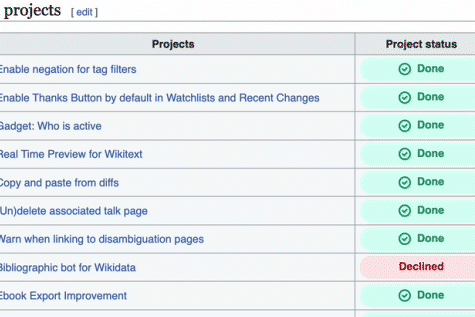Summary: Since 2015, The Community Wishlist Survey has empowered contributors to suggest and vote on improvements or new features for Wikimedia tools and platforms. The Wishlist has gone through many changes, and in 2024, will become a continuous intake system that improves prioritization, resourcing, and communication around wishes. Until the new system is established, the Community Tech team will work on the recently audited backlog of wishes rather than run the survey in February 2024.

Recently, the Chief Product & Technology Officer of the Wikimedia Foundation, Selena Deckelmann, delivered the keynote speech at WikiConference North America. During the talk, she noted that while some pundits see every major technology change as a sign of the impending death of Wikipedia, we are in a moment of multiple, complex challenges that impact the future of our movement. These challenges include the rise of artificial intelligence and declines in editors, admins, and pageviews across our projects. What do we need to do to make Wikipedia and the Wikimedia projects multigenerational, rather than a single-generation wonder? The history of the internet is full of creative projects that have failed to change with the needs of users, available technologies, and both social and cultural landscapes.
For the Wikimedia movement, our success relies on the open collaboration among thousands of volunteers. Volunteers create and curate the content on our platforms every day and around the world. For this reason, improving volunteer workflows is a core function of the product and technology teams at the Wikimedia Foundation. Sometimes this takes the form of major projects; the Foundation’s annual plan for 2023-2024 focuses on the needs of experienced editors, as well as improving the technical infrastructure and data systems that our projects are built on. Other times, it requires smaller collaborations to make rapid progress on the features, tools, and gadgets that volunteers use across the wikis.
Since 2015, the Community Wishlist Survey has attempted to do that. The wishlist is run by the Wikimedia Foundation’s Community Tech team, which works alongside volunteers and other Foundation technical teams on tools and platform improvements. The “wishes” they work on together support content contribution and readership. The wishlist has evolved over the years through iterations and topical discussions to its current format. For example, from 2015-2020, 30 top 10 proposals were completed, 12 were declined and 3 were partially completed. After Community Tech introduced a new prioritization framework in 2021, in only three years 40 wishes were completed (10 by CommTech, 30 by other WMF teams), 15 were partially completed (8 by CommTech, 7 by WMF teams) and one was declined.
While the wishlist provides an important service, it has not been able to keep up with the needs of volunteers, both in terms of the number of wishes shared and the technical complexities of addressing them. Community Tech also knows how much Wikimedians value the wishlist as a way to work together with technical staff and volunteers on tools and features that they use most.
As a result, the Community Tech team has dedicated much of the past year thinking about the way forward. At Wikimania 2023, we presented three broad objectives that we are using to guide changes – 1) improve connections between the wishlist requests and the WMF annual planning, 2) make the intake system accessible to more users, and 3) better collaboration with other developer volunteers and technical groups.
Today I am pleased to share with you some early decisions.
- Creating a new, continuous intake system for community technical requests. We recognize the frustration caused by the current process, which involves several rounds of technical wish writing, discussions, and voting, and does not necessarily translate into the wishes always being prioritized. Instead, the new intake system is intended to provide a clearer and more direct way for community members to submit requests. It will also reduce the time burden volunteers spend on proposals and voting in an annual survey. This system would also gather requests more equitably across Wikimedia communities, more clearly direct work to product and technology teams across the Wikimedia Foundation, and more consistently communicate decision rationales and statuses for wishes-in-progress. We hope to pilot the new system by the second half of 2024.
- The new intake system will be part of our annual planning. Over time, the wishes submitted to the wishlist have grown in complexity. This means working on a single wish often requires coordination across multiple layers of technical work. One way the Foundation already addresses this problem is by having many teams work on community wishes, though we recognize that this is not always well communicated or managed. To better handle this challenge, we will build work on more complex wishes into the Foundation’s annual plan so that they can be resourced and coordinated appropriately. The bridging of the intake system with the broader planning cycles for product and tech work will be led by the incoming Lead Community Tech Manager.
- The Community Tech team will work on wishes from the backlog until this new system is in place. This means not running the wishlist survey in February 2024, while we focus instead on wishes Wikimedians have already voiced as important priorities. When the team begins work on a new wish from the backlog, it will be added to Community Tech’s list of current projects for public visibility. In the meantime, we will also review highly ranked projects from the backlog to see what can be added to next year’s annual plan, so that community members will not need to re-submit them. Wikimedians also have the opportunity to share their ideas and feedback directly into this process, both at an organization level and specifically on our product and technology priorities for each year. See our annual plan’s pages on Product and Technology, OKRs, and Collaboration for examples from last year. We’re eager to hear ideas about how we can better involve wishlist contributors in next year’s process.
- We are piloting community Wishathons to bring more volunteer developers into the wishlist process. A new intake system will help the Foundation better support community-submitted technical problems, but improving our technical functions is a responsibility shared across the Wikimedia movement. During the past year, engineers from various WMF Product and Tech teams have piloted the wishathon sprint format on community wishlist requests. In March 2024, the Community Tech team will be hosting the first community wishathon inviting volunteer developers to also join in the activities. The community wishathon is part of a broader effort to strengthen the role of volunteer developers on the wishlist. More information about the wishathon is available in the announcement post we made a few weeks back.
Community Tech will spend much of January and February improving some submission tooling and onboarding our new Community Tech Manager. When that work is complete, we can start working on the new intake system. We are grateful to everyone who has already taken the time to share their thoughts with us in the past year, both on-wiki and at in-person events. This feedback, plus the team’s published metrics research, offers a strong starting point to design a new system.
Building a better wishlist is something the Community Tech team can’t do alone. We’re hoping to work with all of you on topics like how to better include more communities, making submissions more user-friendly, improving transparency and communication about wishes, and connecting to other technical wishlists in the Wikimedia movement. We will also focus on getting a broad range of perspectives, including Wikimedians who are already active on the wishlist survey, those who are under-represented in the current format, and volunteer developers. This wider outreach will help the wishlist to better serve our communities. Finally, we hope to build on this collaboration in future years, as we continue to test, refine, and evolve the new wishlist format.
We welcome your thoughts and questions, especially on how to co-design the future together, on our talk page. You can also reach out to me, Runa Bhattacharjee or Selena Deckelmann via Talking:2024.

Can you help us translate this article?
In order for this article to reach as many people as possible we would like your help. Can you translate this article to get the message out?
Start translation
